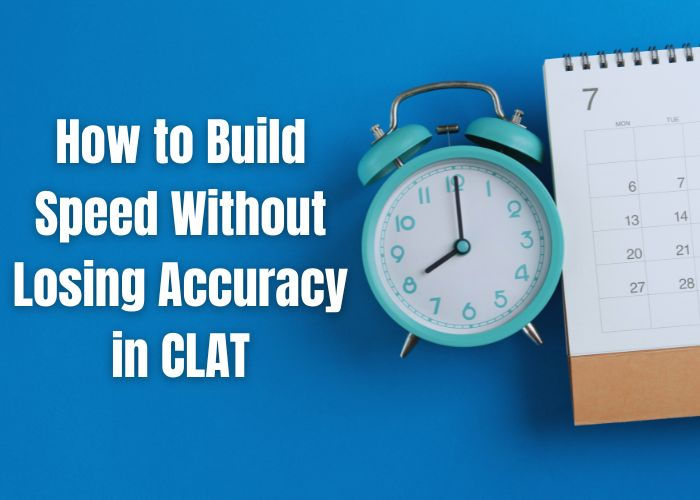How to Build Speed Without Losing Accuracy in CLAT
- kajal lawprep
- Aug 13
- 4 min read

Cracking the Common Law Admission Test (CLAT) is not just about knowing the syllabus—it’s about performing under time pressure. The test demands a unique combination of speed and accuracy, which is where many aspirants struggle. If you try to answer too quickly, you risk making silly mistakes. If you focus too much on accuracy, you might not complete the paper. The key is finding a balance.
In this blog, we’ll explore practical tips, proven strategies, and common pitfalls to help you increase your speed without compromising accuracy, with examples directly relevant to CLAT and similar Indian competitive exams.
Why Speed and Accuracy Both Matter
Many students believe they need to choose between being fast and being correct. In reality, CLAT rewards those who can be both.
Speed ensures coverage: You can attempt all sections within the given time.
Accuracy ensures efficiency: Correct answers mean you don’t waste marks on negative marking.
Balanced approach maximizes score: Even if you attempt fewer questions but with high accuracy, your rank can still soar.
Step 1: Understand the Nature of CLAT Questions
Before we talk about speed, you need to understand how CLAT questions are designed. The test involves reading comprehension, logical reasoning, legal reasoning, quantitative techniques, and current affairs.
Reading-heavy format: You’ll deal with long passages in English and Legal sections.
Reasoning-based answers: Rote learning alone won’t help; you must think critically.
Time-consuming distractions: Some questions are deliberately framed to trap hasty readers.
Example: In Legal Reasoning, a passage may have multiple legal principles hidden in the text. Rushing through could make you miss a vital condition, leading to wrong answers.
Step 2: Master the Art of Skimming and Scanning
Skimming and scanning are not just reading skills—they’re time-management tools.
Skimming: Quickly glance over the passage to understand the gist. Focus on keywords like “however,” “because,” “therefore,” and names of laws.
Scanning: When you have a specific question, go back to locate relevant lines instead of re-reading the entire passage.
Practice Tip: Take a CLAT sample paper and set a stopwatch. Spend 30 seconds skimming each passage before attempting questions. This prevents re-reading and saves precious minutes.
Step 3: Use Timed Practice for Muscle Memory
Solving questions under time pressure trains your brain to process faster.
Start with untimed practice to focus on understanding.
Gradually introduce sectional timers—for example, 8–9 minutes for a reading comprehension set.
Once you’re confident, simulate full-length timed mock tests twice a week.
Many students from CLAT Coaching in Varanasi have shared that their improvement in speed was not from studying harder, but from consistently practicing with strict timers.
Step 4: Prioritize High-Value Questions First
You don’t have to answer every question in order. A smart sequence can save time.
Identify low-hanging fruit: Tackle questions that are short, straightforward, or from your strong areas first.
Mark time-consuming ones for review: Don’t get stuck on a single puzzle or tricky comprehension.
Keep a ‘last 10 minutes’ rule: Use the final minutes for questions you marked earlier.
Example: In Quantitative Techniques, if a graph looks complicated, skip it initially and answer easier number-based questions first.
Step 5: Build Accuracy Through Active Reading
Speed without accuracy comes from careless reading. Avoid this by:
Highlighting or underlining key words in your mind (or on rough paper if allowed).
Pausing at logical breaks to ensure you’ve understood.
Rephrasing questions in your own words before answering.
Step 6: Train Your Brain with Section-Specific Drills
Every section demands a different approach for balancing speed and accuracy.
1 . Reading Comprehension & Legal Reasoning
Focus on paragraph mapping—know where each idea appears.
Avoid excessive note-taking; just mark mental checkpoints.
2 . Logical Reasoning
Recognize question patterns (strengthen/ weaken, cause-effect, assumption).
For puzzles, note key facts first, then start linking them.
3 . Quantitative Techniques
Memorize key formulas and percentage/fraction conversions.
Practice mental math daily for faster calculation.
Step 7: Maintain a Healthy Guessing Strategy
You can’t always be 100% sure, but blind guessing can destroy accuracy.
Use elimination: Remove obviously wrong options first.
Look for patterns: Sometimes options contradict each other—only one can be right.
Avoid over-attempting: If your accuracy is below 70% in mocks, reduce attempts until it improves.
Many aspirants from CLAT Coaching in Kanpur found that improving accuracy by just 10% in mocks boosted their All India Rank significantly—even when speed stayed the same.
Step 8: Keep a Post-Mock Review Habit
Speed and accuracy improve only if you learn from your mistakes.
After every mock, analyze not just wrong answers but also lucky guesses.
Check time spent per question—did you waste too long on one section?
Maintain a “Mistake Log” with types of errors (careless reading, conceptual gap, calculation error).
Step 9: Manage Exam-Day Time Pressure
Even if you practice well, the real exam pressure can cause you to lose composure.
Start with your strongest section for a confidence boost.
Keep a mental time check every 20–25 minutes.
If you hit a roadblock, move on and return later.
Example: If you’re stuck in a long legal reasoning passage at the 10-minute mark, leave it and move to the next set instead of forcing yourself through.
Step 10: Build Mental Stamina
A 2-hour exam requires sustained focus.
Practice full-length papers at the same time of day as the real exam.
Take short breaks during preparation to avoid mental burnout.
Eat light before mocks to avoid sluggishness.
Check this also: CLAT Preparation Strategy: Your Roadmap to NLUs
Common Mistakes That Hurt Both Speed and Accuracy
1 . Reading every word slowly
You won’t finish the paper.
2 . Skipping understanding for speed
You’ll misinterpret questions.
3 . Ignoring mock analysis
Without review, you repeat the same errors.
4 . Relying only on last-minute prep
Speed needs gradual building.
Final Words
Speed and accuracy are like the two wheels of a bicycle—remove one, and you can’t move forward. Building them together takes discipline, smart strategy, and continuous self-analysis. Start slow, focus on understanding, then introduce time pressure, and finally, refine your exam-day execution.
By following these strategies, you’ll not only attempt more questions but also get more of them right—paving the way for a strong CLAT performance.



Comments